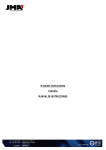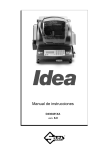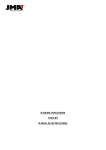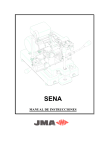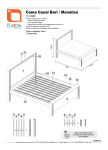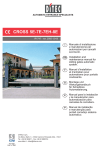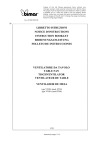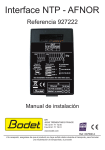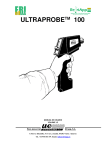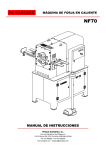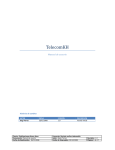Download máquina duplicadora yakarta manual de instrucciones
Transcript
MÁQUINA DUPLICADORA YAKARTA MANUAL DE INSTRUCCIONES Indice: 1 PRESENTACIÓN Y ASPECTOS GENERALES........................................................................ 3 1.1 1.2 1.3 2 GENERALIDADES ............................................................................................................... 3 TRANSPORTE Y EMBALAJE .............................................................................................. 3 ETIQUETA IDENTIFICADORA ........................................................................................... 3 CARACTERÍSTICAS DE LA MÁQUINA.................................................................................. 4 2.1 FAMILIA DE LLAVES.......................................................................................................... 4 2.2 NOMENCLATURA DE LA LLAVE...................................................................................... 4 2.3 COLOCACIONES OPCIONALES ......................................................................................... 5 2.4 ELEMENTOS PRINCIPALES DE LA MÁQUINA ................................................................ 6 2.5 DATOS TÉCNICOS............................................................................................................... 7 2.6 COMPONENTES Y PARTES FUNCIONALES ..................................................................... 8 2.6.1 Accesorios....................................................................................................................... 8 2.6.2 Circuito eléctrico............................................................................................................. 9 2.6.3 Mordaza de tres lados ................................................................................................... 10 2.6.4 Función de la excéntrica................................................................................................ 11 3 OPERATIVIDAD Y FUNCIONAMIENTO .............................................................................. 12 3.1 REGLAJE MÁQUINA ......................................................................................................... 12 3.1.1 Control y reglaje lateral ................................................................................................ 12 3.1.2 Control y reglaje de la profundidad de corte.................................................................. 13 3.2 DUPLICADO DE LLAVES.................................................................................................. 14 3.2.1 Operación de duplicado de la llave gorja....................................................................... 14 3.2.2 Duplicado de la llave frontal ......................................................................................... 15 3.2.3 Duplicado de la llave FO-4P ......................................................................................... 16 3.2.4 Duplicado de la llave gorja mediante tope punta............................................................ 17 3.2.5 Duplicado de la llave FO-6P ......................................................................................... 18 3.2.6 Duplicado de la llave “ABLOY” .................................................................................... 20 3.2.7 Duplicado de la llave con el carro de hacer REGATAS .................................................. 21 4 MANTENIMIENTO Y SEGURIDAD ....................................................................................... 22 4.1 4.2 4.3 CAMBIO DE FRESA ........................................................................................................... 22 CAMBIO DE CEPILLO ....................................................................................................... 22 RECOMENDACIONES DE SEGURIDAD........................................................................... 23 2 1 1.1 PRESENTACIÓN Y ASPECTOS GENERALES GENERALIDADES La máquina duplicadora YAKARTA ha sido diseñada teniendo en cuenta las normas de seguridad vigentes en la C.E.E. La seguridad del personal involucrado en el manejo de este tipo de máquinas solo se consigue con un programa bien diseñado en seguridad personal, como la implantación de un programa de mantenimiento y el seguimiento de los consejos recomendados así como el cumplimiento de las normas de seguridad que contempla este manual. Aunque la instalación de la máquina no presenta ninguna dificultad, es preferible que no intente instalar, ajustar o manipular la misma sin leer primeramente este manual. La máquina sale de nuestra fabrica lista para el uso y solo necesita operaciones de calibrado para los útiles que se van a utilizar: 1.2 TRANSPORTE Y EMBALAJE La máquina se presenta en el interior de un embalaje de las dimensiones siguientes: Ancho = 570 mm, larga = 520 mm, alto = 410mm Peso máquina más embalaje = 29 Kg. de peso. Cuando desembale la máquina, inspeccione cuidadosamente por si hubiese sufrido algún daño en el transporte. Si encuentra alguna anomalía, avise inmediatamente al transportista y no haga nada con la máquina hasta que el agente del transportista haya realizado la inspección correspondiente. 1.3 ETIQUETA IDENTIFICADORA La máquina duplicadora YAKARTA está provista de la etiqueta identificadora, con especificación del numero de serie, nombre y dirección del fabricante, marca CE y año de fabricación. 3 2 CARACTERÍSTICAS DE LA MÁQUINA La máquina duplicadora YAKARTA es de una gran robustez que implica directamente en la precisión de la duplicación. Preparado para el duplicado de llaves de gorja de un paletón y de doble paletón, frontales y especiales. Sistema reversible de doble mordaza, a tres posiciones. Las mordazas presentan dos guías especiales, para su exacto centrado y con un índice copiador con regulación micrométrica. 2.1 FAMILIA DE LLAVES La máquina YAKARTA duplica los siguientes tipos de llaves: - Llaves de gorja de un paletón y de doble paletón. - Llaves frontales. - Llaves especiales. Estandar 2.2 1. 2. 3. 4. ABLOY FORD NOMENCLATURA DE LA LLAVE Cabeza Caña Paletón Dientes 1 2 4 3 4 2.3 COLOCACIONES OPCIONALES Para la consecución de un servicio más completo por parte de esta máquina duplicadora, se han habilitado tres colocaciones opcionales que nos permitirán una mejora en sus prestaciones. COLOCACIÓN RG Ha sido estudiada para la preparación de la regata (estría) de las llaves gorja. COLOCACIÓN FT-COD Nos permite el duplicado, mediante código, de la llave FORD TIBBE. COLOCACIÓN ABL Realizaremos con ella el duplicado de las llaves tipo ABLOY. Estas colocaciones no se incluyen en el precio de la máquina, siendo estas opcionales de compra. 5 2.4 ELEMENTOS PRINCIPALES DE LA MÁQUINA 1. Fresa 2. Cepillo 3. Mordaza 4. Manilla de la mordaza 5. Carro porta mordazas 6. Mango de punto redondo 7. Mango de avance del carro 8. Tope punta abatible 9. Palpador 10. Soporte palpador 11. Interruptor puesta en marcha 12. Pulsador de marcha del cepillo 13. Lampara (Opcional, no suministrada en la básica). 14. Interruptor lampara 15. Mando de regulación del palpador. 16. Interruptor fresa 13 1 12 14 16 11 15 10 9 4 2 3 5 8 2 6 7 6 2.5 DATOS TÉCNICOS Los principales datos técnicos se reflejan a continuación: Motor: Monofásico 220V, 50Hz, 0.18Kw,1500 rpm, 1.6 Amp. Fresa: Acero extra rápido ∅80 x 16 x1,4 mm (tres cortes). Velocidad: 530 rpm. Mordazas: De tres posiciones. Desplazamiento: Con eje deslizante y giratorio. Alumbrado: Lámpara alógena. Dimensiones: Ancho = 400 mm, Profundidad = 460 mm, Alto = 235 mm. Peso: 29 Kg. 7 2.6 COMPONENTES Y PARTES FUNCIONALES 2.6.1 Accesorios 5 3 4 1 1. 2. 3. 4. 5. 2 Piezas de reglaje lateral. Varillas de reglaje de la profundidad de corte. Varilla para el cambio de la fresa (∅7x140). Llave fija de 18. Juego de llaves allen (2.5, 3, 4, 5, 6). 8 2.6.2 Circuito eléctrico Los componentes principales del circuito eléctrico y electrónicos son los siguientes: 1. 2. 3. 4. 5. 6. 7. 8. 9. Toma de corriente Bornas conexión Transformador para lámpara. Interruptor lámpara Lámpara alógena Interruptor puesta en marcha Microinterruptor Pulsador del cepillo Motor 9 2.6.3 Mordaza de tres lados La mordaza está diseñada para sujetar una familia de distintas llaves en cada lado. Vamos a ver los diferentes lados: Lado 1: Lado para duplicar llaves de gorja de un paletón o de doble paletón. Lado 2: Duplicado de llaves frontales. Lado 3: Duplicado de la llave especial FO-4P, en la mordaza reside una ranura a 45º que permite la duplicación de esta llave especial. Para más detalle pasar a los capítulos de duplicación de llaves. 10 2.6.4 Función de la excéntrica • • • La función de la excéntrica es la de centrar el punto redondo del dentado de la llave. Compensa la diferencia del diámetro de caña de los distintos modelos de llave gorja. Ver figura n.º 1 En el cuerpo de la excéntrica aparecen reflejadas cinco posiciones. Una primera posición, indicada con el n.º4, para las llaves que tienen diámetro de caña de 4mm., una segunda posición, que nos marca la pieza, pero que no aparece indicada con ninguna numeración, para las llaves de 5mm. de diámetro de caña, una tercera posición, indicada con el número 6, para llaves de 6mm. de caña, una cuarta posición, cuyo paso nos indica la pieza excéntrica pero que no aparece reflejado con ninguna numeración, para las llaves de 6.5mm. de caña y una última posición, para las llaves de 7mm. de caña. Ejemplo: Si la llave que vamos a mecanizar en la máquina, es de 6mm. de diámetro de caña, la excéntrica tiene que ir colocada en la posición n.º6. Figura n.º 1 11 3 3.1 OPERATIVIDAD Y FUNCIONAMIENTO REGLAJE MÁQUINA 3.1.1 Control y reglaje lateral • Colocar las dos piezas de reglaje (6) • Acercar las mordazas hacia el índice copiador (I) y la fresa (F), de forma que las piezas de reglaje se ajusten sobre el índice copiador y la fresa. El desbloqueo del carro de la máquina se consigue aflojando la manilla(B). • En el caso de no coincidir las piezas de reglaje con la fresa y el índice copiador, actuar de la siguiente manera: • Aflojar los dos tornillos (T) del soporte y mediante una pequeña maza de plástico, dando ligeros golpes a derecha o izquierda de forma que el mismo coincida con la pieza de reglaje. Ver figura n,º 2. • La distancia queda perfectamente regulada, coincidiendo el índice copiador y la fresa con las respectivas piezas de reglaje. Seguidamente, apretar, bloqueándolos, los tornillos (T) del soporte. Figura n.º2 12 3.1.2 Control y reglaje de la profundidad de corte • • Colocar las dos varillas de reglaje (7) en las mordazas, según indica el diseño. Acercar las mordazas con las varillas de reglaje (7) hacia el índice copiador (I) y la fresa (F), de forma que las varillas de reglaje se apoyen sobre el índice copiador y la fresa. El desbloqueo del carro de la máquina se consigue aflojando la manilla (B). • Girar la fresa con la mano. Si la fresa roza ligeramente las varillas de reglaje, la máquina está debidamente regulada. • Si al girar la fresa, ésta lo hace libremente; sin rozar, nos indica que no corta con la suficiente profundidad. Por el contrario, si la fresa queda bloqueada en la varilla de reglaje, nos muestra que el corte es demasiado profundo. • De producirse alguna de estas dos incidencias, proceder de la siguiente forma: • Soltar el tornillo prisionero (L) que bloquea el índice copiador (I) y girar el tornillo micrométrico (H). Ver figura n.º3. • Adelantar o retrasar el índice copiador, hasta que la fresa gire y roce muy ligeramente la varilla de reglaje. A continuación, apretar el tornillo (L) del índice copiador y la máquina queda en perfecto estado de funcionamiento. Figura n.º 3 13 3.2 DUPLICADO DE LLAVES 3.2.1 Operación de duplicado de la llave gorja • • • • Introducir las llaves en las mordazas, teniendo cuidado de que el paletón de la llave apoye sobre el tope interior de la mordaza, según se aprecia en la figura n.º4. Poner la máquina en macha y sosteniendo el carro por medio de la manilla (M), acercar las llaves hacia el índice copiador (I) y la fresa (F). Recomendamos que se ha de trabajar pausadamente, sin forzar la fresa. El punto redondo se consigue, girando el carro portamordazas con la manilla (N). El recorrido del punto redondo se limita con el tope (P). Si en el duplicado se han producido algunas rebabas en la llave duplicada, éstas se eliminarán utilizando el cepillo, que para este fin se ha dotado a la máquina. Figura n.º4 14 3.2.2 Duplicado de la llave frontal • • • • Introducir las llaves en las mordazas, teniendo cuidado de que el paletón de la llave apoye sobre el tope frontal de la mordaza, según se aprecia en la figura nº 5. Poner la máquina en marcha y sosteniendo el carro por medio de la manilla (M), acercar las llaves hacia el índice copiador (I) y la fresa (F). Recomendamos que se ha de trabajar pausadamente, sin forzar la fresa. La perpendicularidad de corte se consigue orientando el carro con la manilla (N). Si en el duplicado se han producido algunas rebabas en la llave duplicada, éstas se eliminarán utilizando el cepillo, que para este fin se ha dotado a la máquina. Figura n.º5 15 3.2.3 Duplicado de la llave FO-4P • • • Colocamos las mordazas de gorja en la posición (C), a continuación, colocamos la llave de tal manera que el paletón se asiente sobre el rebaje de 45º que tiene la mordaza en su lateral, así, le damos los grados de inclinación al dentado de la llave. Le hacemos a la llave tope de punta, fresa-palpador y procedemos al dentado de la misma. Importante: Antes de colocar las llaves en la mordaza verificar la posición de las mismas. Las llaves salen de fábrica con un diente en uno de sus paletones mecanizado. 16 3.2.4 Duplicado de la llave gorja mediante tope punta • Tenemos la pieza denominada “Soporte de punta (A-B), cuya función es la de agilizar la puesta en la mordaza de la llave haciendo tope de punta cuando tenemos que mecanizar varias llaves del mismo modelo. • Situando la pieza en la posición 2, colocamos la llave que vamos a mecanizar de manera que el paletón de la llave choque con el tope “B” de la pieza. A continuación retiramos la pieza (soporte punta) a la posición inicial 1. • Procederemos a la colocación de la llave original y sin mover la llave en bruto, las ajustamos de tal manera que el paletón de la llave en bruto choque con la fresa (C) de la máquina y el paletón de la llave original con el palpador (D). • A continuación procederemos a mecanizar esta primera llave. • Si tenemos que mecanizar una segunda llave, y sin mover la llave original, con solo colocar el Soporte de Punta en la posición n.º 2 y haciendo que choque el paletón de ésta segunda llave a mecanizar con el tope “B” del “Soporte”, tenemos centradas las llaves sin tener que hacer tope en fresa y palpador. 17 3.2.5 Duplicado de la llave FO-6P • LA LECTURA DEL CÓDIGO DE LA LLAVE ORIGINAL La llave original tiene 6 posiciones de duplicado, y para realizar una lectura correcta de ésta, debemos coger la llave con la mano izquierda, es decir, quedando el paletón de la llave a la derecha de la cabeza de plástico negro, tal y como se indica en el dibujo. Las posiciones en el duplicado de la llave, corresponden a combinaciones de 4 distintas alturas que ahora señalamos y vamos a numerar: 1 • • 3 4 La altura n.º1, nos indica que no se debe duplicar. La posición n.º2 nos señala que hay un pequeño rebaje en la llave y que cuando es algo mayor corresponde a la altura n.º3. La altura n.º4 es el mayor de los rebajes de la llave. Entonces cogeríamos la llave y marcaríamos las 6 posiciones, tal y como señalamos a continuación en función de las distintas alturas: A 3 • 2 B 4 C 1 D 2 E 4 F 2 à Este es el código de la llave. Una vez conocido el código de la llave a duplicar, se coloca la llave en bruto en la mordaza, y colocando la pieza (L) en la posición 1, la llave debe de quedar completamente plana tal que si acercamos la llave a la fresa, esta debe hacer marca en el centro de la llave. 18 • • • • • Figura n.º 6 De no ser así, se debe soltar el espárrago (H), y entonces centramos la llave, y utilizamos la pieza (J) realizando el ajuste correcto. La pieza (I) es la bola de código que tiene 6 letras, correspondientes a las 6 posiciones. La pieza (J) sirve para el reglaje vertical. La pieza (K) se utiliza en el reglaje horizontal. La pieza(L) sirve para dar las inclinaciones correctas a la llave, en función de la posición a que corresponda. Haremos un pequeño ejemplo con la lectura anterior: A B C 3 4 1 • • • D E 2 4 F 2 Colocamos la pieza (L) en la posición superior 3, e introducimos el palpador en la bola pieza I en la letra A y efectuamos el duplicado correspondiente. Hacemos la misma operación con la altura 4, introduciendo el palpador en la pieza I en la letra B y comiendo con la fresa la altura correspondiente, y así sucesivamente hasta las 6 posiciones. Posteriormente haremos lo mismo con los 4 números inferiores de la pieza (L), duplicando así, el otro lado de la misma cara de la llave. Para duplicar la otra cara de la llave, damos la vuelta a la misma, y volvemos a realizar la misma operación, utilizando siempre el mismo código, ya que la llave es simétrica, y por ello se mantiene el mismo código. 19 3.2.6 Duplicado de la llave “ABLOY” • • • Colocar dos llaves en bruto, una en cada mordaza a derecha o izquierda y mirar que toque tanto la fresa como el palpador, si la fresa o el palpador no tocase tiene que reglarse. Para el reglaje tienen que aflojarse los tornillos de la pieza 5-14 (que es la regla que lleva en la parte inferior) y podrá moverse todo el útil hacia delante o atrás, hasta que la fresa y el palpador toquen las llaves. Para el tope de punta sería una llave colocando la fresa y la otra llave al palpador. Figura n.º 7 20 3.2.7 Duplicado de la llave con el carro de hacer REGATAS • • Colocar dos llaves en bruto, una en cada soporte a derecha o izquierda y mirar que toque tanto la fresa como el palpador, si la fresa o el palpado no tocase tiene que reglarse. Para el reglaje tienen que aflojarse los tornillos de la pieza 5-14 (que es la regla que lleva en la parte inferior) y podrá moverse todo el útil hacia delante o atrás, hasta que la fresa y el palpador toquen las llaves. Figura n.º8 21 4 MANTENIMIENTO Y SEGURIDAD A la hora de ejecutar cualquier operación de mantenimiento, es necesario cumplir los requisitos: 1. 2. 3. 4. 4.1 CAMBIO DE FRESA • • 4.2 Nunca se debe efectuar ninguna operación con la máquina en marcha. Se debe desconectar el cable de la conexión eléctrica. Se han de seguir estrictamente las indicaciones del manual. Utilizar piezas originales de repuesto. Retirar la guarda que cubre la fresa (F). Introducir la varilla (6) en el agujero del husillo (A) y soltar la tuerca (K) de la fresa que deseamos cambiar con la llave fija. Una vez retirada la fresa a cambiar colocar la nueva realizando la operación inversa. CAMBIO DE CEPILLO • • Para cambiar el cepillo quitar la tapa (P) soltando los 4 tornillos (R) que la sujetan. Seguidamente introducir la varilla (9) en el agujero del eje porta fresas (A) y soltar el tornillo (T) de sujeción del cepillo (C) utilizando la llave ALLEN correspondiente. Después de extraer el cepillo (C) colocar el nuevo actuando de forma inversa. 22 4.3 RECOMENDACIONES DE SEGURIDAD 1. No intente arrancar o manipular la máquina hasta que todos los temas de seguridad, instrucciones para la instalación, guía del operario y procedimientos de mantenimiento, hayan sido cumplimentados y entendidos. 2. Desconecte siempre el suministro eléctrico, antes de realizar cualquier trabajo de limpieza o mantenimiento. 3. Mantener la fresa limpia y libre de virutas. 4. Mantenga siempre limpia la máquina así como su entorno. 5. Se tiene que trabajar con las manos secas. 6. Se tiene que usar gafas de protección, aún que la máquina tenga protección. 7. Asegúrese que la máquina tenga toma a tierra. 23 KEY CUTTING MACHINE YAKARTA INSTRUCTION MANUAL Contents: 1 PRESENTATION AND GENERAL ASPECTS.......................................................................... 3 1.1 1.2 1.3 2 GENERAL POINTS ............................................................................................................... 3 TRANSPORTATION AND PACKING .................................................................................. 3 IDENTIFICATION LABEL.................................................................................................... 3 CHARACTERISTICS OF THE MACHINE............................................................................... 4 2.1 FAMILY OF KEYS................................................................................................................ 4 2.2 PARTS OF A KEY................................................................................................................. 4 2.3 OPTIONAL FITTINGS .......................................................................................................... 5 2.4 MAIN ELEMENTS OF THE MACHINE ............................................................................... 6 2.5 TECHNICAL INFORMATION .............................................................................................. 7 2.6 COMPONENTS AND FUNCTIONAL PARTS ...................................................................... 8 2.6.1 Accessories...................................................................................................................... 8 2.6.2 Electric circuit................................................................................................................. 9 2.6.3 Three-sided clamp ......................................................................................................... 10 2.6.4 Function of the eccentric ............................................................................................... 11 3 HOW THE MACHINE WORKS............................................................................................... 12 3.1 MACHINE ADJUSTMENT.................................................................................................. 12 3.1.1 Control and side adjustment .......................................................................................... 12 3.1.2 Control and adjustment of the cutting depth ................................................................... 13 3.2 KEY CUTTING.................................................................................................................... 14 3.2.1 Cutting mortise lock keys ............................................................................................... 14 3.2.2 Cutting pump keys ......................................................................................................... 15 3.2.3 Cutting FO-4P keys ....................................................................................................... 16 3.2.4 Cutting mortise lock keys using the tip stop .................................................................... 17 3.2.5 Cutting FO-6P keys ....................................................................................................... 18 3.2.6 Cutting “ABLOY” keys.................................................................................................. 20 3.2.7 Cutting keys with the slide for making GROOVES.......................................................... 21 4 MAINTENANCE AND SAFETY .............................................................................................. 22 4.1 4.2 4.3 CHANGING THE MILLING CUTTER................................................................................ 22 CHANGING THE PLANE ................................................................................................... 22 SAFETY RECOMMENDATIONS ....................................................................................... 23 2 1 1.1 PRESENTATION AND GENERAL ASPECTS GENERAL POINTS The YAKARTA key cutting machine has been designed taking into account the safety standards currently in force in the EU. The safety of personnel involved in the handling of this type of machines is only achieved with a well designed worker safety program, the implementation of a maintenance program and following recommended advice as well as compliance with the safety standards included in this manual. Although the machine is not difficult to install, it is best not to try to install, adjust or use it without having first read this manual. The machine leaves our factory ready for use and only requires the carrying out of calibration operations for the tools that are going to be used. 1.2 TRANSPORTATION AND PACKING The machine comes packed in packing of the following size: Width = 570 mm, length = 520 mm, height = 410mm Machine weight plus packing = 29 Kg. When the machine has been unpacked, check whether it has suffered any damage during transportation. If you find any problems, please inform the carrier immediately and do not do anything with the machine until the carrier’s agent has carried out an inspection. 1.3 IDENTIFICATION LABEL The YAKARTA key cutting machine has an identification label, giving the serial number, the name and address of the manufacturer, the CE mark and the year of manufacture. 3 2 CHARACTERISTICS OF THE MACHINE The YAKARTA key cutting machine is very robust, which has a direct effect on its precision. It can cut single and double blade mortise lock keys, pump keys and special keys. Three-position reversible double clamp system. The clamps have two special guides for precise centring and a tracer point with micrometric adjustment. 2.1 FAMILY OF KEYS The YAKARTA machine can cut the following types of keys: - Single and double blade mortise lock keys. - Pump keys. - Special keys. Standar 2.2 1. 2. 3. 4. ABLOY FORD PARTS OF A KEY Head Stem Blade Teeth 1 2 4 3 4 2.3 OPTIONAL FITTINGS In order to get a more complete service from this key cutting machine, three optional fittings are available that enable its features to be improved. RG FITTING It has been designed to prepare the groove in mortise lock keys. FT-COD FITTING Enables you to cut FORD TIBBE keys, by means of a code. ABL FITTING Enables you to cut ABLOY type keys. These fittings are not included in the price of the machine, as they are optional purchases. 5 2.4 MAIN ELEMENTS OF THE MACHINE 1. Milling cutter 2. Plane 3. Clamp 4. Clamp handle 5. Clam-holder slide 6. Rounding handle 7. Slide advance handle 8. Fold-away stop 9. Tracer point 10. Tracer point support 11. Start switch 12. Plane start button 13. Light (Optional, not supplied in basic version). 14. Light switch 15. Tracer point adjustment control. 16. Milling cutter switch 13 1 12 14 16 11 15 10 9 4 2 3 5 8 2 6 7 6 2.5 TECHNICAL INFORMATION The main technical information is as follows: Motor: Single phase 220V, 50Hz, 0.18Kw,1500 rpm, 1.6 Amp. Milling cutter: Extra quick speed steel ∅80 x 16 x1.4 mm (three cuts). Speed: 530 rpm. Clamps: Three positions. Displacement: With sliding and rotating shaft. Lighting: Halogen lamp. Dimensions: Width = 400 mm, Depth = 460 mm, Height = 235 mm. Weight: 29 Kg. 7 2.6 COMPONENTS AND FUNCTIONAL PARTS 2.6.1 Accessories 5 3 4 1 1. 2. 3. 4. 5. 2 Side adjustment parts. Rods for adjusting cutting depth. Rod for changing milling cutter (∅7x140). 18 spanner. Set of Allen keys (2.5, 3, 4, 5, 6). 8 2.6.2 Electric circuit The main components of the electric circuit and the electronic components are as follows: 1. 2. 3. 4. 5. 6. 7. 8. 9. Socket Connection terminals Transformer for light. Light switch Halogen lamp Start switch Microswitch Plane button Motor 9 2.6.3 Three-sided clamp The clamp is designed to secure a different family of keys on each side. These are the different sides: Side 1: Side for cutting single- or double-blade mortise lock keys. Side 2: For cutting pump keys. Side 3: For cutting special FO-4P keys. There is a 45º groove in the clamp, which enables this special type of key to be cut. For more details, proceed to the chapters on key cutting. 10 2.6.4 Function of the eccentric • • • The function of the eccentric is to centre the rounded area of the teeth of the key. It offsets the difference in the stem diameter between the different models of mortise lock key. See figure no. 1. Five positions are marked on the body of the eccentric. The first position, indicated by no. 4, is for keys with a stem diameter of 4mm.. The second position marked, but which is not numbered, is for keys with a stem diameter of 5 mm. The third position, indicated by the number 6, is for keys with a stem diameter of 6 mm. The fourth position, which is marked but not numbered, is for keys with a stem diameter of 6.5mm. The final position is for keys with a stem diameter of 7mm. Example: If the key you are going to machine has a stem diameter of 6 mm, the eccentric has to be in position 6. Figure no. 1 11 3 3.1 HOW THE MACHINE WORKS MACHINE ADJUSTMENT 3.1.1 Control and side adjustment • Fit the two adjustment parts (6) • Move the clamps towards the tracer point (I) and the milling cutter (F), so that the adjustment parts are in the correct position in respect of the tracer point and milling cutter. The machine slide can be released by loosening the handle (B). • If the adjustment parts do not coincide with the milling cutter and tracer point, proceed as follows: • Loosen the two screws (T) of the support and using a small plastic mallet, give a few gently knocks to the right or left so that it coincides with the adjustment part. See figure no. 2. • The distance is now perfectly adjusted, with the tracer point and the milling cutter coinciding with the respective adjustment parts. Now, tighten the screws (T) of the support right up. Figure no. 2 12 3.1.2 Control and adjustment of the cutting depth • • Put the two adjustment rods (7) in the clamps, as shown in the diagram. Move the clamps with the adjustment rods (7) towards the tracer point (I) and the milling cutter (F), so that the adjustment rods rest on the tracer point and the milling cutter. The machine slide can be released by loosening the handle (B). • Turn the milling cutter by hand. If it gently rubs the adjustment rods, the machine is properly adjusted. • If the milling cutter turns freely, without rubbing, this indicates that it is not cutting deeply enough. On the other hand, if the milling cutter becomes jammed up against the adjustment rod, this indicates that it is cutting too deeply. • If either of these two situations should occur, proceed as follows: • Undo the screw (L) securing the tracer point (I) and turn the micrometric screw (H). See figure no. 3. • Move the tracer point forwards or backwards, until the milling cutter turns freely and rubs gently against the adjustment rod. The tighten the tracer point screw (L). The machine is now in perfect working order. Figure no. 3 13 3.2 KEY CUTTING 3.2.1 Cutting mortise lock keys • • • • Insert the keys into the clamps, taking care that the blade of the key rests on the inner stop of the clamp, as shown in figure no. 4. Start the machine and, holding the slide by means of the handle (M), move the keys towards the tracer point (I) and the milling cutter (F). We recommend that you work slowly, without forcing the milling cutter. The rounded area is achieved by rotating the clamp-holder slide with the handle (N). The length of the rounded area is limited by the stop (P). If the key cutting operation has left some burrs on the cut key, these can be eliminated with the plane that the machine has been fitted with for that purpose. Figure no. 4 14 3.2.2 Cutting pump keys • • • • Insert the keys into the clamps, taking care that the blade of the key rests on the front stop of the clamp, as shown in figure no. 5. Start the machine and, holding the slide by means of the handle (M), move the keys towards the tracer point (I) and the milling cutter (F). We recommend that you work slowly, without forcing the milling cutter. The perpendicularity of the cut is achieved by directing the slide with the handle (N). If the key cutting operation has left some burrs on the cut key, these can be eliminated with the plane that the machine has been fitted with for that purpose Figure no. 5 15 3.2.3 Cutting FO-4P keys • • • Put the special clamps in position (C), then fit the key so that the blade rests on the 45º recess the clamp has in its side. This gives the angle to the teeth of the key. Put the key right in until the tip stops on the milling cutter and tracer point and then cut the teeth. Important: Before putting the keys into the clamp, check their position. The keys leave the factory with a machined tooth on one of their blades. 16 3.2.4 Cutting mortise lock keys using the tip stop • We have a part known as the “Tip support” (A-B). Its function is to make it easier to put the key into the clamp, acting as a stop for the tip, when several keys of the same model have to be cut. • Placing the part in position 2, fit the key to be cut so that the blade of the key hits stop “B” of the part. Then withdraw the part (tip support) to the initial position. • Then put the original key into place and without moving the blank key, make adjustments so that the blade of the blank key hits the milling cutter (C) of the machine and the blade of the original key hits the tracer point (D). • Then machine the first key. • If you have to machine a second key, without moving the original key, you just have to place the Tip Support in position no. 2 and ensure that the blade of this second key hits stop “B” of the “Support”. The keys are now centred without having to bring them up against the milling cutter and tracer point. 17 3.2.5 Cutting FO-6P keys • READING THE CODE OF THE ORIGINAL KEY The original key has 6 cutting positions. To read it correctly, you have to take the key in your left hand, that is to say with the blade of the key to the right of the black plastic head, as shown in the diagram. The positions for cutting the key correspond to combinations of 4 different heights, indicated and numbered below: 1 • • 3 4 Height no. 1, indicates that it should not be cut. Position no. 2 indicates that there is a small recess in the key. When it is slightly bigger it corresponds to height no. 3. Height no. 4 is the biggest recess on the key. You then take the key and mark the 6 positions, as shown below based on the different heights: A 3 • 2 B 4 C 1 D 2 E 4 F 2 à This is the code for the key. Once you know the code for the key to be cut, place the blank key in the clamp. Fit the part (L) in position 1, the key must be completely flat so that if the key is moved to the milling cutter, this will make a mark in the centre of the key. 18 • • • • • Figure no. 6 If it does not, loosen the stud bolt (H), and then centre the key, and use the part (J) to make the correct adjustment. The part (I) is the code ball with 6 letters, corresponding to the 6 positions. The part (J) is for vertical adjustments. The part (K) is used for horizontal adjustment. The part (L) is used to angle the key correctly, depending on the corresponding position.. Here is a quick example with the previous reading: A B C 3 4 1 • • • D E 2 4 F 2 Place part (L) in the top position 3, and insert the tracer point in the ball part I in letter A and make the corresponding cut. Do the same operation for height 4, inserting the tracer point in part I in letter B, machining the corresponding height with the milling cutter. Carry on in the same until the 6 positions have been completed. Then do the same with the 4 bottom numbers of the part (L), thereby cutting the other side of the same face of the key. To cut the other face of the key, turn it over and carry out the same operation again, always using the same code, as the key is symmetrical and therefore keeps the same code. 19 3.2.6 Cutting “ABLOY” keys • • • Take two blank keys and put one in each clamp on the right or left and ensure that they touch both the milling cutter and the tracer point. If the milling cutter or tracer point do not touch, adjustments have to be made. To make the adjustments, undo the screws on part 5-14 (which is the rule at the bottom) and you will be able to move the whole tool forward or back, until the milling cutter and the tracer point touch the keys. To stop the tip, ensure that one key touches the milling cutter and the other the tracer point. Figure no. 7 20 3.2.7 Cutting keys with the slide for making GROOVES • • Take two blank keys and put one in each support on the left or right and ensure they touch the milling cutter and the tracer point. If the milling cutter or tracer point do not touch, adjustments have to be made. To make the adjustments, you have to loosen the screws in part 5-14 (which is the rule at the bottom) and move the whole tool forward or back, until the milling cutter and the tracer point touch the keys. Figure no. 8 21 4 MAINTENANCE AND SAFETY When carrying out maintenance operations, the following requirements must be met: 1. 2. 3. 4. 4.1 CHANGING THE MILLING CUTTER • • 4.2 Never carry out any operation with the machine switched on. The machine must be unplugged. The indications in this manual must be strictly adhered to. Only original spare parts must be used. Remove the guard covering the milling cutter (F). Insert the rod (6) into the hole in the spindle (A) and undo the nut (K) of the milling cutter you want to change with a spanner. Once the milling cutter to be changed has been removed, fit the new one by reversing the above process. CHANGING THE PLANE • • To change the plane, remove the cover (P) by taking out the 4 screws (R) that hold it. Then insert the rod (9) into the hole in the milling cutter holder shaft (A) and undo the screw (T) securing the plane (C), using the corresponding ALLEN key. After removing the plane (C), fit the new one by reversing the process. 22 4.3 SAFETY RECOMMENDATIONS 1. Do not try and start or use the machine until all safety matters, installation instructions, operators guides and maintenance procedures have been fulfilled and understood. 2. Always switch off the power supply before carrying out any cleaning or maintenance operations. 3. Keep the milling cutter clean and free from filings. 4. Keep the machine and the area around it clean. 5. Work with dry hands. 6. Use safety glasses, even if the machine is fitted with guards. 7. Ensure that the machine is earthed. 23














































